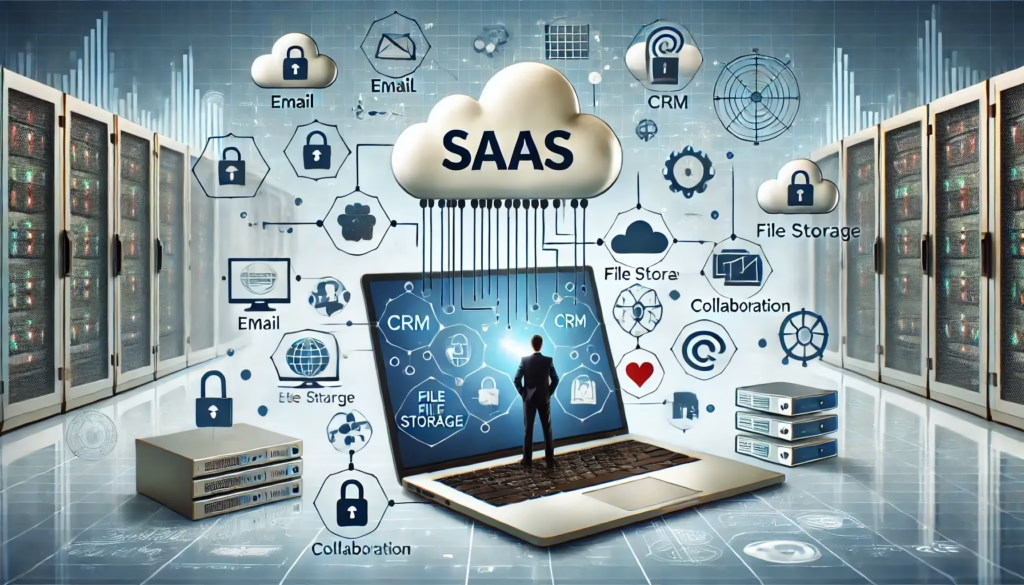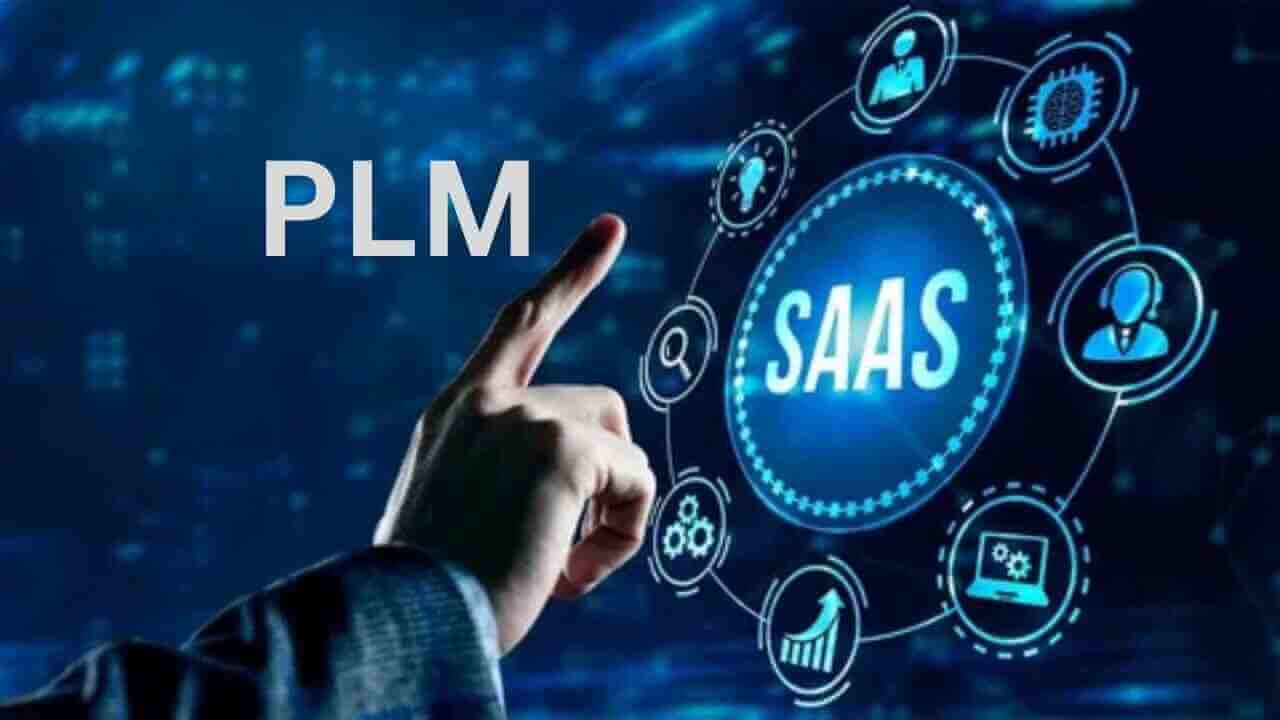What is Software as a Service (SaaS) in Cloud Computing?
Imagine being capable of run powerful business software program with out ever needing to install it, replace it, or maybe fear about it breaking. Sounds magical, right? Well, that’s what Software as a Service (SaaS) grants within the world of cloud computing.
In simple terms, SaaS is a way of delivering software program over the internet—as a service. Instead of purchasing software once and installing it on your own computer, you join it. The software program runs on the company’s servers, and at the same time you also get right of enter through your browser.

To better understand “What is Software as a Service (SaaS) in Cloud Computing?”, First of all it is beneficial to feel what cloud computing is. In simple words, cloud computing means using the net to access and store data or programs rather than using the hard drive of your computer.
Think of it like renting a place on someone else’s super-powerful computer. SaaS is one part of cloud computing. Just like you use cloud services to keep your pictures or watch films on-line, SaaS lets you use software like email or accounting tools without installing anything. Everything runs online, which saves you time, money, and effort. So when we talk about SaaS, we are actually talking about one of the easiest and most beneficial methods that cloud computing facilitates in everyday lifestyles and enterprise.
Let’s make it real: When you use Google Docs, you’re not installing anything. You just open your browser, log in, and you’re exact to move. That’s SaaS in action — maybe with out even understanding it!
Let’s dive deep into What is Software as a Service (SaaS) in Cloud Computing and the way it is reshaping the virtual world?
✅ Why SaaS Matters
- No need for high-end hardware.
- No complicated installations or configurations.
- Instant access from anywhere.
- Always updated software.
This shift from “proudly owning” to “renting” software is on the middle of cloud computing—and it’s one of the motives more groups are ditching traditional models and shifting to the cloud.
Software as a Service (SaaS) in Cloud Computing: A Beginner’s Guide
Let’s break it down: Software as a Service (SaaS) in cloud computing refers to programs hosted on cloud servers and delivered over the internet. These applications are absolutely controlled by way of a third-party issuer.
You don’t have to:
- Maintain any infrastructure.
- Handle software updates.
- Troubleshoot bugs manually.
All that heavy lifting? That is taken care of by the SaaS provider.
Instead of buying, installing, and keeping software, you virtually join it. Providers like Salesforce, Zoom, and Dropbox host the packages on their own servers. You get entry to the software program through an internet browser, from any device, anytime.
🧠 Think of it like Netflix
You don’t download movies—you stream them. You don’t worry about movie storage or updates. Similarly, with SaaS, you just “stream” your software via your browser.
🌐 How SaaS fits into the Cloud Ecosystem
There are three essential layers of cloud computing:
- Infrastructure as a Service (IaaS) – raw computing power (e.g., AWS EC2).
- Platform as a Service (PaaS) – tools to build and install programs (e.g., Google App Engine).
- Software as a Service (SaaS) – equipped-to-use software program (e.g., Dropbox, Zoom, Salesforce).
SaaS sits on top, offering the very best access point for organizations into the cloud.
How SaaS Applications Work in the Cloud
Behind the scenes, SaaS applications rely upon a concept referred to as multi-tenancy. This way multiple users (or “tenants”) percentage the equal infrastructure, but their information is kept completely separate.
🛠️ Here’s what SaaS providers manage for you:
- Servers and infrastructure.
- Data storage and backups.
- Security protocols and patches.
- Automatic software updates.
- Customer support.
🧩 What do YOU manage?
- Your account settings.
- Your data inputs.
- Your user permissions.
That’s it. Everything else? Not your responsibility.
This setup lets companies skip high priced installations and protection, saving both money and time.
This structure allows SaaS apps to scale immediately—whether you’re a startup with 10 customers or an enterprise with 10,000.
Software as a Service (SaaS) in Cloud Computing: Examples
Let’s look at real-world SaaS in cloud computing examples to bring things to life.
🔍 CRM Systems
- Salesforce is one of the earliest and most successful SaaS businesses.
- It helps companies manage their customer data and automate their sales processes.
- No servers, no installations—just log in and go.
📁 File Sharing
- Dropbox and Google Drive are perfect SaaS examples.
- Shopify lets entrepreneurs open online stores without worrying about web hosting or coding.
- Users store, share, and collaborate on documents in real time.
🧾 Accounting Tools
- QuickBooks Online facilitates small businesses manage budget, payroll, and taxes.
💬 Collaboration Platforms
- Slack and Microsoft Teams are essential for remote workforces.
- Zoom lets people host meetings without installing complex teleconferencing systems.
- Google Workspace offers email, calendars, and document editing — all online.
In all of these cases, users don’t buy a product—they subscribe to a service.
All of these are SaaS applications living in the cloud, serving millions daily.
Software as a Service (SaaS) in Cloud Computing: PDF Resources
You don’t have to be a techie to learn more about SaaS in cloud computing. Whether you’re a student, startup founder, or IT manager, there are tons of resources available to dig deeper.
📚 Top PDF Resources
Want to learn even more?
Here are excellent free SaaS PDF resources:
- NIST Definition of Cloud Computing (PDF) – the official U.S. government publication that defines all cloud models.
- IBM Cloud SaaS Overview (PDF) – details benefits and architectures.
- IBM SaaS Architecture Guide (PDF) — explains how SaaS models are built.
- AWS SaaS Lens (PDF) – tips for developers building SaaS apps on AWS.
These resources are incredibly valuable for students, business owners, and tech enthusiasts alike.
📘 Why These PDFs Matter
They help:
- Students write accurate reports.
- Developers build secure SaaS apps.
- Managers make informed software decisions.
💡 Pro Tip: Bookmark these PDF guides. They offer insights you won’t find in advertising brochures.
Advantages of SaaS Over Traditional Software
So why are companies—from scrappy startups to international giants—ditching conventional software program for SaaS applications? The advantages are hard to ignore:
💰 Cost Savings
You pay only for what you use. There’s no need for expensive licenses, physical servers, or in-house IT teams to maintain your system. With SaaS, everything’s bundled into one predictable subscription.
🧩 Easy Integration
Most SaaS applications offer built-in integrations or support popular APIs. That means your CRM can talk to your email marketing software, and your payment gateway can sync directly with your accounting tools.
🔒 Built-in Security
Top-tier SaaS vendors make investments closely in safety. You get company-grade information encryption, normal protection patches, and 24/7 tracking—without hiring a single security engineer.
🌍 Global Accessibility
With an internet connection, your team can work from anywhere. Whether your graphic designer is in Toronto or your sales rep is in Tokyo, SaaS keeps your operations in sync.
⚡ Automatic Updates
Say goodbye to update prompts and compatibility issues. SaaS solutions update in the background, which means you usually use the most modern-day model—with out lifting a finger.
Instead of worrying about tech complications, you may focus on growing your enterprise or getting your job done.
Anecdote: From On-Premise Chaos to SaaS Simplicity
Meet Linda, a small business owner running a boutique marketing agency. For years, her team juggled outdated project management software installed on clunky office desktops. Each update meant a full day of IT downtime, not to mention the cost of licenses and support.
One day, her developer suggested switching to Asana—a SaaS-based project management platform. It took only minutes to sign up. No installations. No downtime. And everyone on her team could log in from anywhere—even during lunch breaks or while commuting.
Three months later, project timelines were tighter, team communication had improved, and client satisfaction hit an all-time high. Linda never looked back.
Linda’s story is not unique. Thousands of businesses experience similar “aha” moments when they move to SaaS.
That’s the magic of SaaS in cloud computing—ease, efficiency, and scalability.
Software as a Service (SaaS) in Cloud Computing: Applications
Let’s talk power players—the SaaS applications that have completely changed how businesses run.
| Application | Category | Function |
| Salesforce | CRM | Manage customer data and sales pipelines |
| Zoom | Communication | Video conferencing and webinars |
| Slack | Team Messaging | Team collaboration through channels |
| Shopify | E-Commerce | Run online stores |
| Mailchimp | Marketing Automation | Run email campaigns |
| Trello | Project Management | Visual task tracking |
| FreshBooks | Accounting | Track expenses and invoices |
These apps are not just tools—they may be commercial enterprise lifelines. They are game changers, not only for large businesses however for freelancers and solopreneurs, too. The high-quality component you can get started out with a lot of them totally free and improve as you grow.
Software as a Service (SaaS) in Cloud Computing: Challenges
Of course, SaaS is not all rainbows and unicorns, it offers huge benefits. There are few demanding situations to keep in mind.
⚠️ Internet Dependency
If your net connection is unstable or slow, you’ll struggle to access your tools.
🔐 Data Privacy Concerns
You are trusting some other corporation together with your sensitive information. That’s why it’s vital to choose providers that are GDPR or HIPAA compliant, depending in your industry.
🔌 Limited Customization
While many SaaS applications offer customization, they may not meet every unique business requirement out of the box.
🔄 Vendor Lock-In
Migrating data out of a SaaS platform can be complex. Make sure you understand data export policies before committing.
Despite these troubles, the professionals overwhelmingly outweigh the cons for maximum groups—especially when starting out or scaling quick.
However, these are manageable with the right planning and provider choice.
How SaaS Compares to Platform as a Service (PaaS)
To apprehend the whole scope of cloud computing, it’s crucial to evaluate SaaS with every other key layer: Platform as a Service (PaaS).
| Feature | SaaS | PaaS |
| Users | End-users | Developers |
| Control | Minimal – just app settings | Full – build your own apps |
| Examples | Google Workspace, Dropbox | Heroku, Google App Engine |
| Use Case | Productivity, CRM, accounting | Building and deploying apps |
🧠 Think of It This Way:
- SaaS is like renting a totally-provided office.
- PaaS is like renting an empty space where you can design the office however you want.
If you’re a non-tech business just looking for tools to get stuff done, SaaS is your go-to. If you’re a dev team looking to build software, PaaS is your playground.
Why SaaS is Ideal for Small and Medium Enterprises
When you are counted a small or medium-sized business (SMB), every dollar, every hour, and each selection. That’s where SaaS in cloud computing actually shines.
🔑 Key Reasons SMBs Love SaaS:
- Zero Infrastructure Costs: No need for servers, in-house IT teams, or large data facilities.
- Faster Deployment: SaaS apps can be deployed in mins, no longer months.
- Budget-Friendly: Pay-as-you-go pricing allows small agencies control cash flow efficiently.
- No Maintenance Hassles: Let your provider handle backups, patches, and protection.
💡 Example: A small e-commerce startup the use of Shopify can launch a complete -fledged save on-line within hours—no coding, no hosting, simply easy configuration.
And with tools like Mailchimp and FreshBooks, even solo entrepreneurs can run high-quality advertising campaigns and track finances like a pro.
Software as a Service (SaaS) in Cloud Computing: Security
Whenever we talk about SaaS packages, specially in industries like healthcare, finance, or training, the first situation is always: Is it secure?
🛡️ The Good News
Top SaaS providers follow best practices in cloud security, including:
- Data Encryption keeps your data safe (in transit and at rest)
- Role-Based Access Control
- Two-Factor Authentication (2FA)
- Regular Penetration Testing
- Disaster Recovery Plans
For industries with strict rules, many SaaS quipment are HIPAA-compliant, SOC 2 certified, or ISO 27001 certified.
⚠️ But You Still Need to Be Vigilant
- Choose reputable vendors with solid SLAs.
- Read privacy policies thoroughly.
- Regularly audit permissions and user access levels.
🔐 Pro Tip: Don’t just consider the brand—check for third-party security audits and customer reviews.
💡 Always choose relied on carriers and take a look at their certifications.
How to Choose the Right SaaS Provider
Choosing the right SaaS provider can make or spoil your workflow. Here’s a step-by-step manual that will help you compare your alternatives smartly:
📋 Step-by-Step Evaluation:
- Define Your Needs:
- What problem are you solving?
- What functions are ought to-haves vs. High-quality-to-haves?
- Check Scalability:
- Can the software grow with your business?
- What are the pricing tiers?
- Test the Interface:
- Is the UI user-friendly?
- Do your team members find it intuitive?
- Assess Integration Options:
- Does it work with your existing tools?
- Are there built-in connectors or APIs?
- Review Security and Compliance:
- Do they offer data encryption, 2FA, and backups?
- Are they compliant with relevant regulations?
- Compare Support Levels:
- Do they offer 24/7 support?
- Is live chat available?
- Read Real Customer Reviews:
🎯 Remember: The right SaaS is one that doesn’t just solve today’s problems—but is ready for tomorrow’s growth too.
Choosing the right provider means long-term success without regrets.
Future Trends in SaaS and Cloud Computing
SaaS in cloud computing is evolving fast. Here’s what’s around the corner:
🌐 AI and Automation
More SaaS tools will embed AI for smarter decision-making, predictive analytics, and customer personalization.
🔄 Interoperability & API-First SaaS
Expect more seamless integration across different tools via APIs, reducing silos and boosting data flow.
📱 Mobile-First Everything
As more people work remotely, mobile-first SaaS will become the norm, with powerful apps that rival their desktop counterparts.
🔒 Hyper-Focus on Security
With rising data threats, zero-trust architecture and advanced encryption will be core to SaaS platforms.
🧠 Low-Code / No-Code Platforms
SaaS tools will empower non-developers to build apps the use of drag-and-drop builders, with out writing a single line of code.
In brief: SaaS will simplest get faster, smarter, and even extra user- friendly.
✅ Conclusion: SaaS is the Future of Business Software
So, what is Software as a Service (SaaS) in Cloud Computing? It’s extra than a software program transport version—it’s a revolution in how groups operate.
SaaS provides:
- Speed
- Simplicity
- Scalability
- Cost-efficiency
- Accessibility
Whether you are a solo entrepreneur or a big business enterprise, SaaS programs provide you with the power to work smarter, not tougher.
Are you ready to improve your business tools? Take the leap and discover the vast world of SaaS today.
This is not just the future — it is a smart choice today.


